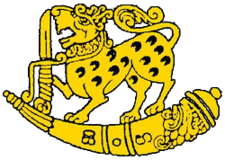The first public appearance of the Battalion took place on 4thFebruary 1958 when the 1st Battalion Ceylon Sinha Regiment took part in the Independence Day Parade. The Commanding Officer Lieutenant Colonel RD Jayatillake MBE himself commended the parade. The public was fascinated by witnessing the extraordinary drill and marching displayed by the troops of the Sinha Regiment.
On 25th March 1958, the Battalion saw the arrival of two young officers 2nd Lieutenant ARW Delgoda and 2nd Lieutenant DSDE Soyza both having completed their Young Officers' Course at Elton Hall, United Kingdom.
In April 1958 the Sinha Regiment for the first time deployed its troops on an internal security role when the 'B' Company was moved to Laxapana to protect the hydro power station which was the main source of electricity supply to the national grid and to help maintain law and order in that area.
During mid May 1958, the Regiment was detailed to be engaged in operations against illegal immigration and the 'A' & 'B' Companies of the Battalion took over what was known as 'Force M' duties based at the Thodaweli Camp. Major MO Goonaratne was appointed as the Force Commander and Major CAB Ratnayake as his deputy. However, even before they could concentrate on the shores of the Mannar District, 'emergency' was declared due to communal riots that erupted all over the country. An island wide curfew was declared and troops were deployed in many parts of the country on internal security duties. Later, in August 1958 having the 'A' Company returned to the Thodaweli Camp in Mannar and the 'B' Company to Diyatalawa.
2nd Lieutenant A Ariyapperuma, a member of the first batch to have passed out from Army Training Centre at Diyatalawa joined the Battalion in November 1958. Much later, he joined Gemunu Watch and was appointed the Brigade Commander, Jaffna holding the rank of Colonel. While serving in Jaffna he was killed due to action by the separatist terrorists and was posthumously promoted to the rank of Brigadier.
With the second batch of officers passing out from the Army Training Centre, Diyatalawa, 2nd Lieutenant D Wijesinghe and 2nd Lieutenant VCD Adhietti joined the battalion in April 1959. However, the latter left after a short stint the Army.
In 1959 with the participation of the Battalion at the Independence Day Parade the public witnessed for the second time the high quality of drill and marching displayed by the 9 officers and 160 others of the Sinha Regiment who took part in it. Maintaining a speed of 140 phases per minute the contingent was applauded by the public who witnessed the Parade.
In March 1959 island wide strike action by the employees of the Ceylon Transport Board (CTB) and the Ceylon Government Railway (CGR) brought about a breakdown of transport services. In response, 'Operation Daimler' was launched and troops of the Sinha Regiment were deployed in key towns of Uva, Sabaragamuwa and Central Provinces.
In June 1959 the Regiment was deployed to handle cargo at the Colombo Harbour. This was due to strike action by the trade unions. 10 Officers and 400 men of the Battalion moved to the Anderson Camp, Narahenpita from where they engaged in work at the harbor up to August 1959 when the harbour operations returned to its routine.
In December 1959 a Guard of Honour was presented to Major Generaleral AM Muttukumaru at the Rendezvous Ground in Diyatalawa to bid farewell to him on his retirement as the Commander of the Army. On this occasion, for the first time the Ceylon Sinha Regiment presented a display of arms drills in the absence to any commands but, to music played by the attending band. Drill movements were carried out both when stationary and whilst on the move. Music was played by the No. 2 Army Band based at Diyatalawa under Sergeant Peiris GA. Four groups of soldiers stood at the four corners of the Rendezvous Ground where they first performed while stationary then marched to the centre of the ground while carrying out drill movements with the rifle until they finally doubled off the ground. This spectacle was initiated by Warrant Officer II Morseth TFB on his return from following a training course in drill at Pirbright.
In December 1959, 2nd Lieutenant TRT Jayatunge joined the Battalion, having completed his Officer Cadet Training at the Royal Military Academy (RMA), Sandhurst, UK.
In February 1960, 12 officers and 240 other ranks took part in the Independence Day Parade. For the first time the public witnessed personnel of the 1st & 2nd Battalions of the Sinha Regiment attired in olive green drill order uniforms thus becoming the talking point for quite some time thereafter





